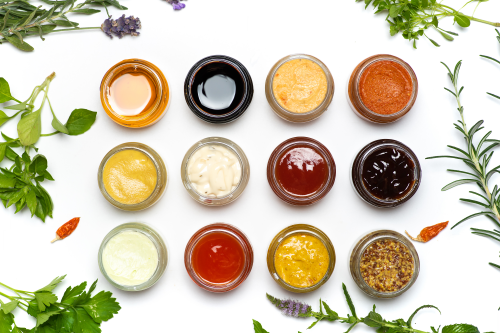Flavor Fatigue Setting In? Sauce it Up

Chicken again? Has your initial determination to make dietary changes started to falter? Perhaps your once “go-to” meals have gradually become flat and boring. Flavor fatigue is very common and many people feel unmotivated when choices are repetitive. Chefs know this, too, and have been expertly squashing flavor fatigue for years. Their trick? Sauces!
- Sauces add richness, flavor and moisture to a dish. Drier foods such as grilled meats, roasts or meatloaf are often enhanced with sauces and gravies. What would baby back ribs be without barbecue sauce?
- Sauces can harmonize a meal using similar flavors across the components of the dish. Think of a Hollandaise sauce containing egg yolks on eggs Benedict.
- Lastly, sauces add visual appeal. A pop of drizzled red sauce against a beige background can make all the difference between a bland meal and a fancy restaurant feel.
What’s in the sauce?
Sauces are thickened liquids that are made up of three parts: a base stock liquid, a thickening agent, and seasonings for flavor. The trick to making hundreds of different combinations stems from a base group of what is called the “five mother sauces.” Conquering these five recipes will give you the keys to unlock hundreds of different combinations. Once you know the basics, you’ll be able to adapt recipes for your personal sodium, phosphorus and potassium goals.
The five French mother sauces are:
- Hollandaise: egg yolks, unsalted butter, lemon juice, water, cayenne pepper, salt and black pepper. Serve over an English muffin and egg.
- Velouté (white sauce with stock): white stock, butter, flour, salt and white pepper. Use as a gravy base, mushroom sauce or on poached or steamed chicken or fish.
- Béchamel (white sauce with dairy): butter, flour, whole milk, salt and nutmeg. Use to add flavor to bland veggies, macaroni and white lasagna.
- Espagnole (brown sauce): butter, flour, brown stock, tomato puree (tailor the amount of tomatoes to your potassium goals), carrot, onion, celery, garlic, peppercorns and bay leaf. Serve over beef, lamb or pork, or add to rice or risotto.
- Tomato (red sauce): white stock, butter, salt, flour (optional), tomatoes (tailor the amount of tomatoes to your potassium goals), thyme, carrots, onion, bay leaf, garlic, salt, pepper and sugar. Serve over pasta or make a pizza.
How to Avoid Lumpy Gravy
The trick to adding thickeners to sauces requires patience. A gradual, thorough, continuous whipping technique will prevent lumps from forming. Bring the liquid to a boil to hold it at its thickest potential. Afterwards, you can add more delicate kidney-friendly ingredients to enhance flavor. These may include wine, lemon juice, vinegar, herbs and seasonings.
Try these kidney-friendly sauce recipes from DaVita.com.
Roasted Red Pepper Tomato Sauce
White Gravy for Casseroles and Pot Pies
Search the web or your favorite cookbooks to find sauce recipes and enjoy bringing the sauce to your kitchen!
References:
- https://www.everydayhealth.com/diet-nutrition/what-are-5-basic-mother-sauces/
- https://www.cooksmarts.com/cooking-lessons/creating-flavor/sauces/
Additional Kidney Diet Resources
Visit DaVita.com and explore these diet and nutrition resources:
DaVita Kidney-Friendly Recipes
This article is for informational purposes only and is not a substitute for medical advice or treatment. Consult your physician and dietitian regarding your specific diagnosis, treatment, diet and health questions.

Recent Comments